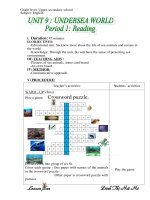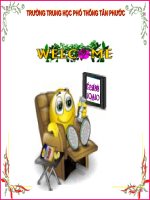Reading-Unesco
Bạn đang xem bản rút gọn của tài liệu. Xem và tải ngay bản đầy đủ của tài liệu tại đây (51.51 KB, 2 trang )
I. READING
A. Choose the correct word or phrase - a, b, c or d - that best completes the passage.
The traditional definition of literacy is considered to be the ability to read and write, or the ability to use language to,
read, write, listen, and speak. In modern contexts, the word refers to reading and writing at a level (31) _____ for
communication, or at a level that lets one understand and communicate ideas in a literate society,' so as to take (32)
_______ in that society. The United Nations, Educational, Scientific and Cultural Organization (UNESCO) has drafted the
following definition: “Literacy is the ability to identify, understand, interpret, create, communicate and compute, using
printed and written 'materials (33) _______ with varying contexts. Literacy involves a continuum of learning to enable an
Individual to achieve his or her goals, to develop his, or her (34) _______ and potential, and to participate fully in the
wider society."
Many policy analysts consider literacy rates a crucial measure of a region's human capital. This claim is made on the
(35) _______ that literate people can be trained less expensively than illiterate people, generally have a higher socio-
economic (36) _______ and enjoy better health and employment prospects. Policy makers also argue that literacy
increases job opportunities and access to higher education. In Kerala, India, for example, female and child mortality rates
declined (37) _______ in the 1960s, when girls who were educated in the education reforms after 1948 began to raise
families. Recent researchers, (38) _______, argue that correlations such as, the one listed above may have more to do
with the effects of schooling rather than literacy in general. Regardless, the (39)_______ of educational systems
worldwide includes a basic (40) _______ around communication through test and print, which is the foundation of most
definitions of literacy.
1. a. important b. adequate c. adaptable d. suitable
2. a. control b. comfort c. part d. honor
3. a. associated b. worked c. appropriated d. related
4. a. ability b. knowledge c. behavior d. performance
5. a. basics b. ways c. foundations d. grounds
6. a. status b. request c. condition d. state
7. a. actually b. dramatically c. extremely d. accurately
8. a. therefore b. however c. consequently d. additionally
9. a. main b. majority c. focus d. demand
10. a. concept b. content c. contact d. context
B. Read the passage carefully, then choose the correct answers.
A literate population is a necessity for any nation wishing to take advantage of modern technological growth. For
.instance, research has shown a direct relationship between literacy among women and improved health' and child care
in the family. The United Nations Educational, Scientific, and Cultural Organization (UNESCO) has long supported the
concept that education must be considered an ongoing process.
Adult education has long been important in Europe, where formal programs began in the 18th century. In Britain,
concern for the education of poor and working-class people resulted in the growth of adult education programs, such as
the evening school and the, Mechanic's Institute, to expand education opportunities for all people: ,After the Russian
Revolution, the Russian government virtually eliminated illiteracy through the establishment of various institutions and
extension classes for adults.
In other areas of the world, adult education movements are of a more recent origin. In 1960, Egypt established a
'schools for the people' system designed to educate the adult population. In the 1970s, countries in Africa, Asia, and
Latin America began to increase opportunities for adult education. Innovative programs involving the mass media are
being used in many countries. Tanzania, for example, has used mass education techniques and the radio to organize
national education programs in health, nutrition, and citizenship. In the 1980s, international educational exchange
programs grew in popularity in the United States and many other countries.
11. What does this passage mainly discuss?
a. National education b. Illiteracy eradication
c. Adult education d. Primary education
12. It can be inferred from this passage that education ________.
a. help people to read and write
b. is an important factor in the country's development
c. is a constant process
d. must only be given to adults
13. Which of the followings is not' true?
a. Adult education has boomed in Europe in recent years.
b. Educated women know how to take care of their children properly.
c. Illiteracy is almost erased in Russia.
d. In many countries, mass education is carried out through television.
14. Which of the followings is not mentioned as means used for mass education?
a. radio b. newspapers c. internet d. textbooks
15. According to the passage, adult education ________.
a. offers opportunities for promotion
b. is to educate people to improve their health
c. is popular all over the world nowadays
d. has been developed thanks to the mass media









